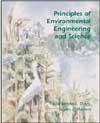 |  Principles of Environmental Engineering and Science Mackenzie L Davis,
Michigan State University - East Lansing
Susan J Masten,
Michigan State University - East Lansing
Book Preface| PREFACEPrinciples of Environmental Engineering is geared toward students taking an introductory, sophomore-level engineering course. The book’s material is also applicable for students enrolled in upper level biology, chemistry, resource development, fisheries and wildlife, microbiology, and soil sciences courses. These students should already understand such calculus topics as differentiation, integrations and differential equations [at an introductory level].
Principles of Principles
Many of you are familiar with Introduction to Environmental Engineering by Mackenzie Davis and David Cornwell. While some of the content of IEE is similar to Principles of Environmental Engineering, these are two separate books with very different objectives. Principles places more emphasis on scientific principles, ethics, and safety, and focuses less on engineering design. This book exposes students to a broader range of environmental topics through separate chapters on ecosystems, geological and soil resources, and agricultural impacts.
True to its emphasis on an inclusive introduction to environmental topics, the first five chapters of Principles present the background of the discipline from which the following chapters spring. For example, Chapter 2 reviews chemistry topics essential for grasping the fundamentals of environmental engineering.
Another hallmark feature of Principles is its integration of mass balance. Chapter 3 introduces the concept of mass balance as a tool for problem solving and shows how it is applied in hydrology conservative systems. From this point on, mass balance explains many key environmental engineering concepts. For example, this approach illustrates conservation of soil and geological resources in Chapter 7 and develops the DO sag curve in Chapter 8 [water quality]. The design equations for a completely mixed activated sludge system and a sludge mass balance are developed in Chapter 10. Mass balance accounts for the production of sulfur dioxide from the combustion of coal in Chapter 11. Finally, in Chapter 13, mass balance is used for waste audit.
SupplementsPrinciples offers a website stocked with tools for both students and instructors at www.mhhe.com/davismasten. Students find animations that put relevant chemistry and geology topics in motion, a glossary of key terms, links to plant tours and other environmental engineering resources, and information on Chem Skill Builder, a chemistry problem-solving application with more than 1500 algorithmically generated questions.
At the Principles website, instructors will find a bank of book images, lecture slides, information on Chem Skill Builder, and the Instructor’s Solutions Manual featuring sample course outlines and solved exams. Instructors can access these tools by contacting their local McGraw-Hill sales representative for password information.
Acknowledgements
As with any other text, the number of individuals who have made it possible far exceeds those
whose names grace the cover. At the hazard of leaving someone out, we would like to explicitly
thank the following individuals for their contribution.
The following students helped to solve problems, proofread text, prepare illustrations, raise
embarrassing questions, and generally make sure that other students could understand it: Shelley
Agarwal, Stephanie Albert, Deb Allen, Mark Bishop, Aimee Bolen, Kristen Brandt, Jeff Brown,
Amber Buhl, Nicole Chernoby, Rebecca Cline, Linda Clowater, Shauna Cohen, John Cooley, Ted
Coyer, Marcia Curran, Talia Dodak, Kimberly Doherty, Bobbie Dougherty, Lisa Egleston, Karen
Ellis, Craig Fricke, Elizabeth Fry, Beverly Hinds, Edith Hooten, Brad Hoos, Kathy Hulley, Lisa
Huntington, Angela Ilieff, Alison Leach, Gary Lefko, Lynelle Marolf, Lisa McClanahan, Tim
McNamara, Becky Mursch, Cheryl Oliver, Kyle Paulson, Marisa Patterson, Lynnette Payne, Jim
Peters, Kristie Piner, Christine Pomeroy, Susan Quiring, Erica Rayner, Bob Reynolds, Laurene
Rhyne, Sandra Risley, Lee Sawatzki, Stephanie Smith, Mary Stewart, Rick Wirsing, Ya-yun Wu.
To them a hearty thank you!
The authors would also like to thank Pamela Augustine, David Desteiger, Cheryl Edson,
John Engle, Timothy Greenleaf, Erin Henderson, Robert Little, Jeremy Mansell, Kelly
Mlynarek, Brad Osinski, Shannon Simpson, Lindsay Smith, Bryan Stramecki, Brad Vernier,
Marcie Wawzysko, and Adam Wosneski who also helped proofread the text, check problems and
make the book more readable for students. In addition, we wish to thank Rebecca Masten-Davies
for her assistance with providing a cultural experience for students by naming cities, rivers, lakes,
etc. after mythological beings from the world over.
We would also like to thank the following reviewers for their many helpful comments and
suggestions: David Bagley, U of Toronto; Theodore Cleveland, U of Houston; Benoit Cushman-
Roisin, Dartmouth College; Brian Dempsey, Penn State U; Andrew Dzuril, Florida State U;
Subhasis Ghoshal, McGill U; Mark Hernandez, U of Colorado; Howard Liljestrand, U of Texas,
Austin; Taha Marhaba, NJIT; Thomas Overcamp, Clemson U; Michael Penn, U of Wisconsin,
Platteville; Kelly Rusch, Louisiana State U; Richard Schuhmann, Penn State U.; Daniel Smith,
U of South Florida; Helena Solo-Gabriele, U of Miami; and Scott Wells, Portland State U.
We give special thanks to Simon Davies for his contribution of Chapter 14. His efforts are
sincerely appreciated. And last, but certainly not least, we wish to thank our families who have
put up with us during the writing of this book, especially Rebecca and Jeffrey Masten-Davies,
who gave up several Christmas vacations plus many other days during the year while their mom
spent uncountable hours working on this book.
A special thanks to Mack's wife, Elaine, for putting up with the nonsense of book writing.
Mackenzie L. Davis and Susan J. Masten
|
|




 2004 McGraw-Hill Higher Education
2004 McGraw-Hill Higher Education